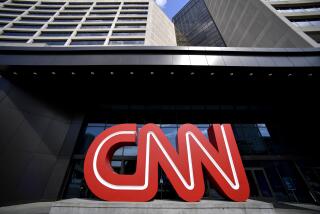News about the news
- Share via
This era is like no other in American journalism: People are consuming more news than ever before, but they’re also far more critical of its purveyors than they’ve ever been. We remain generally agreed that a free press is democracy’s cornerstone, but there’s less consensus than ever on what the news media ought to be -- or, for that matter, what rapid technological, economic and demographic change will allow it to be.
That makes three sets of little-noticed numbers released this week of more than passing interest.
The first set has to do with the audiences of the three cable news networks. For the first time, CNN’s prime-time broadcasts will finish the year in third place, behind Fox and MSNBC among the 25- to 54-year-old viewers advertisers regard as the desirable television audience. To some, that seems to suggest that the television news audience is increasingly split along ideological lines. Fox has made itself king of the prime-time ratings hill by programming a slate of right-wing commentators, while MSNBC has set itself up as the progressive alternative. CNN’s attempt to play it down the journalistic middle looks like a ratings loser.
So, is the lesson here that most Americans want their news refracted through the sort of forthrightly ideological lens both Fox and MSNBC now provide? No, and here’s why. First of all, the universe of cable news viewers, while growing, remains relatively small. Fox’s average prime-time audience increased an impressive 10% in 2009, but it still was just 699,000. MSNBC averaged 307,000 viewers and CNN 299,000. (A reasonably sized U.S. newspaper rolls up comparable numbers.) Moreover, over any given 24-hour period in 2009, the average Fox audience was 320,000; CNN had 185,000 viewers and MSNBC 149,000.
What these numbers suggest is that the cable networks attract a relatively small national audience of what might be called “news junkies,” who follow events throughout the day and are more likely to be strongly partisan than other Americans. By the time evening rolls around, they’re hungry for analysis rather than recycled reportage, and like most Americans today, they prefer interpretation that reinforces their own opinions. The significance of this preference tends to be exaggerated because news junkies include most of the people who write about the media.
Overall, in fact, the cable networks’ audience pretty much resembles that of more conventional print and broadcast news organizations in that it’s relatively old -- and getting older. The average Fox viewer is 64, while a typical CNN watcher is 62 and an MSNBC viewer 59. It’s also interesting to note that CNN’s determination to position itself as the most traditional of the three cable news operations is paying big dividends in the digital realm, where its website is far and away the most frequently visited.
That brings us to an even more interesting set of numbers released this week by Scarborough Research,
a partnership of the Nielsen and Arbitron ratings services. Its most recent survey found that three out of every four American adults -- roughly 171 million people -- continue to read the print or online edition of a newspaper each week.
When the survey broke the numbers down into those who continue to read their paper’s print edition, the findings were even more striking: In any given week, 84% of all American college graduates read a print newspaper, as do 82% of all adults with annual household incomes of at least $100,000 and 79% of all adults employed in white-collar positions.
Even though Scarborough’s data reflected the continuing slow decline in print readership, its senior vice president, Gary Meo, concluded that “reports about the pending death of the newspaper industry are greatly exaggerated.”
But, unlike CNN, which is backing its bet on traditional, nonpartisan journalism by expanding its news-gathering operations, American newspapers have continued to slash staffs. According to the federal Bureau of Labor Statistics, by the time New Year’s Day rolls around, the country’s papers will have eliminated another 40,000 jobs, the most in any year on record and twice last year’s loss of 21,000. According to the bureau, the total number of American newspaper jobs has declined over the last decade from 424,500 to 284,220. This paper’s readers, for example, rely on the efforts of about half as many journalists as 10 years ago.
The Scarborough survey’s findings, and the success of CNN’s digital news site, suggest a continuing hunger on the part of the best-educated and affluent Americans for what’s traditionally been called “straight news.” The question now is whether, once the recession recedes, U.S. papers will be in a position to satisfy it.
More to Read
The biggest entertainment stories
Get our big stories about Hollywood, film, television, music, arts, culture and more right in your inbox as soon as they publish.
You may occasionally receive promotional content from the Los Angeles Times.









